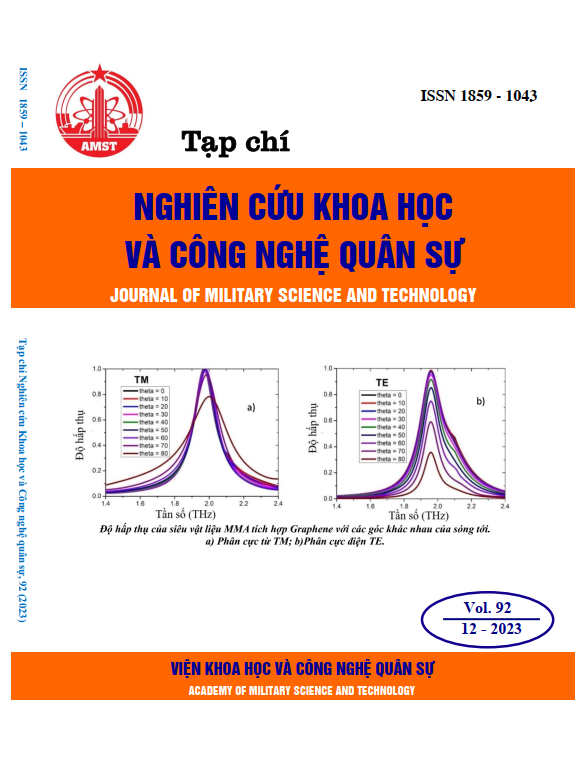Frequency and voltage control in microgrid-based hybrid DFIG -BESS in island mode
808 viewsDOI:
https://doi.org/10.54939/1859-1043.j.mst.92.2023.3-11Keywords:
Microgrid; Doubly Fed Induction Generator; Battery Energy Storage System; Frequency and voltage control.Abstract
Wind power using a Doubly Fed Induction Generator (DFIG) is widely used due to its many outstanding features. However, in the microgrid (MG) in off-grid mode, the DFIG needs support from other sources to be able to work stability. This paper proposes a model of DFIG combined with a battery energy storage system capable of self-maintaining grid voltage and frequency during isolation from the system grid. The converter control system attached to the BESS is built to increase the flexibility of the proposed model, taking into account the state of the system grid, local load needs, and allowable capacity of the BESS, as well as the wind speed. This paper also simulated and analyzed the results when the microgrid disconnected from the system grid on the tool Matlab/Simulink. The frequency and voltage response of the proposed model, when isolation occurs, are completely within the allowable limits.
References
[1]. M. E. Hossain, “Improvement of transient stability of DFIG based wind generator by using of resistive solid state fault current limiter,” Ain Shams Engineering Journal, vol. 9, no. 4, pp. 2557–2570, (2018). DOI: https://doi.org/10.1016/j.asej.2017.03.014
[2]. J. J. Justo, et al, “Doubly-fed induction generator based wind turbines: A comprehensive review of fault ride-through strategies,” Renewable and Sustainable Energy Reviews, vol. 45. Elsevier Ltd, pp. 447–467, (2015). doi: 10.1016/j.rser.2015.01.064. DOI: https://doi.org/10.1016/j.rser.2015.01.064
[3]. E. Bekiroglu and M. D. Yazar, “MPPT Control of Grid Connected DFIG at Variable Wind Speed,” Energies (Basel), vol. 15, no. 9, (2022), doi: 10.3390/en15093146. DOI: https://doi.org/10.3390/en15093146
[4]. Cardenas, Roberto, et al. “Control Strategies for Enhanced Power Smoothing in Wind Energy Systems Using a Flywheel Driven by a Vector-Controlled Induction Machine.” IEEE Transactions on Industrial Electronics. Institute of Electrical and Electronics Engineers, (2001). https://doi.org/10.1109/41.925590. DOI: https://doi.org/10.1109/41.925590
[5]. C. Abbey and G. Joos, “Supercapacitor energy storage for wind energy applications,” IEEE Trans Ind Appl, vol. 43, no. 3, pp. 769–776, (2007), doi: 10.1109/TIA.2007.895768. DOI: https://doi.org/10.1109/TIA.2007.895768
[6]. Q. Li, S. S. Choi, Y. Yuan, and D. L. Yao, “On the determination of battery energy storage capacity and short-term power dispatch of a wind farm,” IEEE Trans Sustain Energy, vol. 2, no. 2, pp. 148–158, (2011), doi: 10.1109/TSTE.2010.2095434. DOI: https://doi.org/10.1109/TSTE.2010.2095434
[7]. T. T. Nguyen, H. J. Yoo, and H. M. Kim, “Application of model predictive control to bess for microgrid control,” Energies (Basel), vol. 8, no. 8, pp. 8798–8813, (2015), doi: 10.3390/en8088798. DOI: https://doi.org/10.3390/en8088798
[8]. L. Huang et al, “Challenges and potential solutions of grid-forming converters applied to wind power generation system—An overview,” Front Energy Res, vol. 11, (2023), doi: 10.3389/fenrg.2023.1040781. DOI: https://doi.org/10.3389/fenrg.2023.1040781
[9]. T.-T. Nguyen, T. Vu, S. Paudyal, F. Blaabjerg, and T. L. Vu, “Grid-Forming Inverter-based Wind Turbine Generators: Comprehensive Review, Comparative Analysis, and Recommendations,” (2022), [Online]. Available: http://arxiv.org/abs/2203.02105
[10]. Gholamrezaie, et al. “An Optimal Frequency Control Method Through a Dynamic Load Frequency Control (LFC) Model Incorporating Wind Farm.” IEEE Syst. J., 12, 392–401, (2018). DOI: https://doi.org/10.1109/JSYST.2016.2563979
[11]. Shahabi, M.; Haghifam, M.R.; Mohamadian. “Microgrid Dynamic Performance Improvement Using a Doubly Fed Induction Wind Generator.” IEEE Trans. Energy Convers, 24, 137–145, (2009). DOI: https://doi.org/10.1109/TEC.2008.2006556
[12]. Han, Y.; Ha, J. “Droop Control Using Impedance of Grid-Integrated DFIG within Microgrid”. IEEE Trans. Energy Convers, 34, 88–97, (2019). DOI: https://doi.org/10.1109/TEC.2018.2861819
[13]. Mendis, N.; Muttaqi, K.M.; Perera, S. “Active power management of a super capacitor-battery hybrid energy storage system for standalone operation of DFIG based wind turbines”. In roceedings of the 2012 IEEE Industry Applications Society Annual Meeting, Las Vegas, NV, USA, 7–11; pp. 1–8, (2012). DOI: https://doi.org/10.1109/IAS.2012.6374045
[14]. Mendis, N.; Muttaqi, K.M.; Perera, S. “ Management of Low- and High-Frequency Power Components in Demand-Generation Fluctuations of a DFIG-Based Wind-Dominated RAPS System Using Hybrid Energy Storage”. IEEE Trans. Ind. Appl. 50, 2258–2268, (2014). DOI: https://doi.org/10.1109/TIA.2013.2289973
[15]. Fakhari Moghaddam Arani at al. “Dynamic Droop Control for Wind Turbines Participating in Primary Frequency Regulation in Microgrids”. IEEE Trans. Smart Grid, 9, 5742–5751.TSG.2017.2696339, (2018). DOI: https://doi.org/10.1109/TSG.2017.2696339
[16]. M. G. Molina and J. Manuel Gimenez Alvarez, “Technical and Regulatory Exigencies for Grid Connection of Wind Generation.” [Online]. Available: www.intechopen.com
[17]. Institute of Electrical and Electronics Engineers, 2018 IEEE Canadian Conference on Electrical & Computer Engineering (CCECE).
[18]. M. Alibeik and E. C. dos Santos, “High-Torque Electric Machines: State of the Art and Comparison,” Machines, vol. 10, no. 8. MDPI, (2022). doi: 10.3390/machines10080636. DOI: https://doi.org/10.3390/machines10080636
[19]. T. Tigerprints and P. Hazra, “Enhancement of Inertial Response of Inverter Based Energy Enhancement of Inertial Response of Inverter Based Energy System and Its Application for Dynamic Performance System and Its Application for Dynamic Performance Improvement of a Microgrid Improvement of a Microgrid,” (2020). [Online]. Available: https://tigerprints.clemson.edu/all_theses
[20]. Tremblay, O.; Dessaint, L.-A. Experimental Validation of a Battery Dynamic Model for EV Applications. World Electr. Veh. J., 3, 289-298, (2009). https://doi.org/10.3390/wevj302028” DOI: https://doi.org/10.3390/wevj3020289
[21]. A. Yazdani and R. Iravani, “A unified dynamic model and control for the voltage-sourced converter under unbalanced grid conditions,” IEEE Transactions on Power Delivery, vol. 21, no. 3, pp. 1620–1629, (2006). DOI: https://doi.org/10.1109/TPWRD.2006.874641







